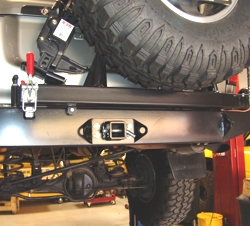Stock Rear Bumper Receiver - Made It Stronger
In a bid for increased clearance, I removed my clearance robbing tow hitch and am installing this Slee receiver:

I had some misgivings about using this with the stock bumper until I started cutting the hole in the bumper and crossmember, which together are approaching 1/4" thick. The hitch extends behind the crossmember and is then triangulated to the frame, bolting up to where the tire carrier plate would normally bolt.
Given the bracing and triangulation that exists in the stock crossmember, plus the additional triangulation of this receiver, this is looking like more than enough for recovery and moderate towing without compromising clearance. I had been looking at this as an interim solution, but seeing what it would take to increase clearance for a custom bumper, i.e. cutting the frame and relocating the crossmember...I'm gonna leave it alone. There is a lot more strength back there than I had been assuming.
I'll post pics tomorrow when it is fully bolted up.
Nay
In a bid for increased clearance, I removed my clearance robbing tow hitch and am installing this Slee receiver:

I had some misgivings about using this with the stock bumper until I started cutting the hole in the bumper and crossmember, which together are approaching 1/4" thick. The hitch extends behind the crossmember and is then triangulated to the frame, bolting up to where the tire carrier plate would normally bolt.
Given the bracing and triangulation that exists in the stock crossmember, plus the additional triangulation of this receiver, this is looking like more than enough for recovery and moderate towing without compromising clearance. I had been looking at this as an interim solution, but seeing what it would take to increase clearance for a custom bumper, i.e. cutting the frame and relocating the crossmember...I'm gonna leave it alone. There is a lot more strength back there than I had been assuming.
I'll post pics tomorrow when it is fully bolted up.
Nay
Last edited:








 . Just get some longer 3" bolts and washers for the bottom holes and take it all the way through the crossmember.
. Just get some longer 3" bolts and washers for the bottom holes and take it all the way through the crossmember.